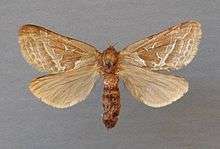Orange swift
For the butterfly with this common name, see Parnara amalia.
| Orange swift | |
|---|---|
 | |
 | |
| Triodia sylvina, male | |
| Scientific classification | |
| Kingdom: | Animalia |
| Phylum: | Arthropoda |
| Class: | Insecta |
| Order: | Lepidoptera |
| Family: | Hepialidae |
| Genus: | Triodia |
| Species: | T. sylvina |
| Binomial name | |
| Triodia sylvina (Linnaeus, 1761) | |
| Synonyms | |
| |
The orange swift (Triodia sylvina), also known as "orange moth" (but see Angerona prunaria), is a species of moth belonging to the family Hepialidae. It was previously placed in the genus Hepialus. It is distributed throughout Europe.


Illustration from John Curtis's British Entomology Volume 5
This species has a wingspan of 32–48 mm. The male has rich orange forewings with two white bars forming a "v" shape. The hindwings are dark brown. The female is similar but generally larger and less brightly coloured. It flies at night from June to September and is attracted to light.
The larva feeds on the roots of various plants including bracken, dandelion, dock, hop and viper's bugloss. This species overwinters twice as a larva.
- ^ The flight season refers to the British Isles. This may vary in other parts of the range.
References
- Chinery, Michael, Collins Guide to the Insects of Britain and Western Europe 1986 (Reprinted 1991)
- Skinner, Bernard, Colour Identification Guide to Moths of the British Isles 1984
External links
![]() Media related to Triodia sylvina at Wikimedia Commons
Media related to Triodia sylvina at Wikimedia Commons
This article is issued from Wikipedia - version of the 11/18/2016. The text is available under the Creative Commons Attribution/Share Alike but additional terms may apply for the media files.